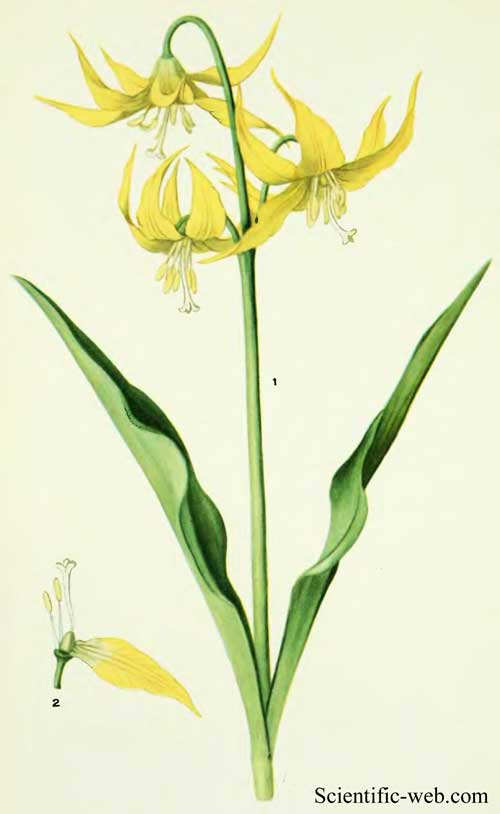
Erythronium grandiflorum
Classification System: APG IV
Superregnum: Eukaryota
Regnum: Plantae
Cladus: Angiosperms
Cladus: Monocots
Ordo: Liliales
Familia: Liliaceae
Subfamilia: Lilioideae
Genus: Erythronium
Species: Erythronium grandiflorum
Name
Erythronium grandiflorum Pursh, Fl. Amer. Sept. 1: 231 (1813).
Synonyms
Heterotypic
Erythronium giganteum Lindl., Edwards's Bot. Reg. 21: t. 1786 (1835).
Erythronium grandiflorum var. giganteum (Lindl.) Hook., Fl. Bor.-Amer. 2: 182 (1838).
Erythronium grandiflorum f. giganteum (Lindl.) Voss, Vilm. Blumengärtn. ed. 3, 1: 1115 (1895).
Erythronium grandiflorum var. minus Hook., Fl. Bor.-Amer. 2: 182 (1838).
Erythronium grandiflorum var. maculatum A.Murray bis, Gard. Chron., n.s., 1: 832 (1874).
Erythronium maximum Douglas ex Baker, J. Linn. Soc., Bot. 14: 298 (1874).
Erythronium speciosum Nutt. ex Baker, J. Linn. Soc., Bot. 14: 298 (1874).
Erythronium grandiflorum var. parviflorum S.Watson, Proc. Amer. Acad. Arts 26: 129 (1891).
Erythronium parviflorum (S.Watson) Goodd., Bot. Gaz. 33: 67 (1902).
Erythronium obtusatum Goodd., Bot. Gaz. 33: 67 (1902).
Erythronium grandiflorum var. robustum Tubergen, Nursery Cat. (van Tubergen) 1905(Flowerroots): 19 (1905).
Erythronium leptopetalum Rydb., Fl. Rocky Mts.: 165 (1917).
Erythronium utahense Rydb., Fl. Rocky Mts.: 165 (1917).
Erythronium grandiflorum var. pallidum H.St.John, Res. Stud. State Coll. Wash. 2: 113 (1931).
Erythronium pallidum (H.St.John) G.N.Jones, Univ. Wash. Publ. Biol. 7: 58 (1938).
Erythronium grandiflorum subsp. chrysandrum Applegate, Contr. Dudley Herb. 1: 190 (1933).
Erythronium grandiflorum var. chrysandrum (Applegate) Scoggan, Fl. Canada 1: 51 (1978).
Erythronium nudipetalum Applegate, Contr. Dudley Herb. 1: 189 (1933).
Erythronium grandiflorum var. nudiflorum C.L.Hitchc., Vasc. Pl. Pacif. N. W. 1: 787 (1969).
Distribution
Native distribution areas:
.
Continental: Northern America
Regional: Western Canada
Alberta, British Columbia.
Regional: Northwestern U.S.A.
Colorado, Idaho, Montana, Oregon, Washington, Wyoming.
Regional: Southwestern U.S.A.
California, Utah.
Regional: South-Central U.S.A.
New Mexico.
References: Brummitt, R.K. 2001. TDWG – World Geographical Scheme for Recording Plant Distributions, 2nd Edition
References
Primary references
Pursh, F.T. 1813 "1814". Flora Americae Septentrionalis, or, A systematic arrangement and description of the plants of North America. Vol. 1. xxxv + 358 pp., London: White, Cochrance, and co. BHL Reference page.
Additional references
Allen, G.A. & Robertson, K.R. 2002. Erythronium. Pp. 153–164 in Flora of North America Editorial Committee (ed.), Flora of North America North of Mexico. Volume 26: Magnoliophyta: Liliidae: Liliales and Orchidales. 723 pp. Oxford University Press, New York / Oxford, ISBN 0-19-515208-5. efloras Reference page.
Links
Govaerts, R. et al. 2022. Erythronium grandiflorum in Kew Science Plants of the World Online. The Board of Trustees of the Royal Botanic Gardens, Kew. Published online. Accessed: 2022 July 22. Reference page.
Tropicos.org 2022. Erythronium grandiflorum. Missouri Botanical Garden. Published online. Accessed: 22 July 2022.
International Plant Names Index. 2022. Erythronium grandiflorum. Published online. Accessed: July 22 2022.
Vernacular names
Deutsch: Großblütiger Hundszahn
English: Yellow Avalanche-lily, Pale Fawn-lily, Yellow Fawn-lily, Glacier Lily
français: L'érythrone à grandes fleurs
Erythronium grandiflorum is a North American species of plants in the lily family.[1] It is known by several common names, including yellow avalanche lily, glacier lily, and dogtooth fawn lily.[2][3] The Ktunaxa name for glacier lily is maxa.[4]
Description
Erythronium grandiflorum grows from a deep bulb (or corm) which is 3 to 5 centimeters wide. Its two green leaves are wavy-edged and up to 20 centimeters long. The stalk may reach 30 centimeters tall and bears one to three showy flowers. Each flower has bright lemon yellow petals, white stamens with large white to yellow to red anthers, and a white style.[5]
The Flora of North America recognizes two subspecies, the yellow-flowered subsp. grandiflorum and the white- to cream-flowered subsp. candidum.[6] More recent publications consider subsp. candidum to be a distinct species, called Erythronium idahoense.[1]
Distribution and habitat
It is native to western North America from British Columbia and Alberta south to New Mexico and California, though it has not been reported from Arizona or Nevada.[7] It can be found in subalpine mountain meadows, slopes, and clearings.[1][8]
Ecology
The flower is pollinated by bumblebees and other bees. The bulbs are an important and preferred food of the grizzly bear. Mule deer readily eat the foliage.[9][10][11]
Uses
The bulbs can be eaten cooked, or raw to avoid starvation[12] (though they can cause nausea this way).[13] The leaves and flowers are also edible raw or cooked.[14]
References
Kew World Checklist of Selected Plant Families
Jepson Manual Treatment
United States Department of Agriculture Plants Profile
"FirstVoices- Ktunaxa. Plants: food plants: words". Retrieved 2012-07-07.
"Yellow Avalanche Lily, Erythronium grandiflorum". calscape.org.
Flora of North America 26 Page 156, Glacier-lily, Erythronium grandiflorum Pursh, Fl. Amer. Sept. 1: 231. 1814
Biota of North America Program 2014 county distribution map
Clennett, C. (2014). The genus Erythronium: 1-158. Kew Publishing, Kew.
Pursh, Frederick Traugott. 1814. Flora Americae Septentrionalis 1: 231
Hitchcock, C. H., A.J. Cronquist, F. M. Ownbey & J. W. Thompson. 1969. Vascular Cryptogams, Gymnosperms, and Monocotyledons. 1: 1–914. In C. L. Hitchcock Vascular Plants of the Pacific Northwest. University of Washington Press, Seattle.
Applegate, Elmer Ivan. 1933.
Reiner, Ralph E. (1969). Introducing the Flowering Beauty of Glacier National Park and the Majestic High Rockies. Glacier Park, Inc. p. 36.
Benoliel, Doug (2011). Northwest Foraging: The Classic Guide to Edible Plants of the Pacific Northwest (Rev. and updated ed.). Seattle, WA: Skipstone. p. 91. ISBN 978-1-59485-366-1. OCLC 668195076.
Nyerges, Christopher (2017). Foraging Washington: Finding, Identifying, and Preparing Edible Wild Foods. Guilford, CT: Falcon Guides. ISBN 978-1-4930-2534-3. OCLC 965922681.
Retrieved from "http://en.wikipedia.org/"
All text is available under the terms of the GNU Free Documentation License

